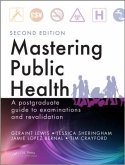Paul Thomas (GP and UK University of West London)
Collaborating for Health
Paul Thomas (GP and UK University of West London)
Collaborating for Health
- Broschiertes Buch
- Merkliste
- Auf die Merkliste
- Bewerten Bewerten
- Teilen
- Produkt teilen
- Produkterinnerung
- Produkterinnerung
Designed to prevent the problems of fragmented care, community-oriented integrated care (COIC) focuses on building teams, networks and communities for health and care at local level, where it is easier to see the range of factors that affect peopleâ s health. This book introduces COIC.
Andere Kunden interessierten sich auch für
![Mastering Public Health Mastering Public Health]() Geraint LewisMastering Public Health140,99 €
Geraint LewisMastering Public Health140,99 €![Public Health Research Methods for Partnerships and Practice Public Health Research Methods for Partnerships and Practice]() Public Health Research Methods for Partnerships and Practice53,99 €
Public Health Research Methods for Partnerships and Practice53,99 €![Global Health Experiential Education Global Health Experiential Education]() Global Health Experiential Education55,99 €
Global Health Experiential Education55,99 €![Challenges in Primary Mental Health Care Challenges in Primary Mental Health Care]() Challenges in Primary Mental Health Care40,99 €
Challenges in Primary Mental Health Care40,99 €![Handbook of Refugee Health Handbook of Refugee Health]() Handbook of Refugee Health89,99 €
Handbook of Refugee Health89,99 €![What do I say next? Everyday Mental Health Conversations in Primary Care What do I say next? Everyday Mental Health Conversations in Primary Care]() Sophie Jadwiga BallWhat do I say next? Everyday Mental Health Conversations in Primary Care41,99 €
Sophie Jadwiga BallWhat do I say next? Everyday Mental Health Conversations in Primary Care41,99 €![Spiritually Competent Practice in Health Care Spiritually Competent Practice in Health Care]() Spiritually Competent Practice in Health Care191,99 €
Spiritually Competent Practice in Health Care191,99 €-
-
-
Designed to prevent the problems of fragmented care, community-oriented integrated care (COIC) focuses on building teams, networks and communities for health and care at local level, where it is easier to see the range of factors that affect peopleâ s health. This book introduces COIC.
Produktdetails
- Produktdetails
- Verlag: Taylor & Francis Ltd
- Seitenzahl: 308
- Erscheinungstermin: 1. Dezember 2017
- Englisch
- Abmessung: 234mm x 156mm x 17mm
- Gewicht: 472g
- ISBN-13: 9781138300026
- ISBN-10: 1138300020
- Artikelnr.: 49154603
- Herstellerkennzeichnung
- Libri GmbH
- Europaallee 1
- 36244 Bad Hersfeld
- gpsr@libri.de
- Verlag: Taylor & Francis Ltd
- Seitenzahl: 308
- Erscheinungstermin: 1. Dezember 2017
- Englisch
- Abmessung: 234mm x 156mm x 17mm
- Gewicht: 472g
- ISBN-13: 9781138300026
- ISBN-10: 1138300020
- Artikelnr.: 49154603
- Herstellerkennzeichnung
- Libri GmbH
- Europaallee 1
- 36244 Bad Hersfeld
- gpsr@libri.de
Paul Thomas is a general practitioner in west London, professor of primary care research, education and development at the University of West London, UK, and honorary senior lecturer at Imperial College, UK. He is editor-in-chief of the London Journal of Primary Care, an international, Pubmed-cited journal that publishes case studies of integrated working in primary care and local communities.
Introduction
Part I. Policy to support integrated working
Chapter 1. Communities for health
Chapter 2. Shared care for long-term conditions
Chapter 3. Seasons of learning and change
Chapter 4. Infrastructure of facilitation and communication
Part II. Integrating care and promoting health from local organisations
Chapter 5. Annual cycles of participatory action research
Chapter 6. Live manuals
Chapter 7. How to see connections between parts and wholes
Chapter 8. How to run meetings that make sense of multiple perspectives
Part III. Integrating care and promoting health from geographic localities
Chapter 9. Engaging people in cycles of inter-organisational learning and
change
Chapter 10. Large group events help people to creatively interact
Chapter 11. Structured inquiry - an important ingredient
Chapter 12. Maintain inner peace
Part IV. Understanding community-oriented integrated care
Chapter 13. The story of community-oriented integrated care
Chapter 14. General practitioners are sense-makers
Chapter 15. Health, identity and relationships
Chapter 16. Three paradigms of inquiry illuminate evolving stories
Part V. Community-oriented integrated care - making it work
Chapter 17. Networks for complicated journeys
Chapter 18. Developing team players and systems thinkers
Chapter 19. Learning organisations build teams and communities
Chapter 20. Public health and primary care - an essential partnership
Appendix: Skills to lead community-oriented integrated care
Bibliography
Part I. Policy to support integrated working
Chapter 1. Communities for health
Chapter 2. Shared care for long-term conditions
Chapter 3. Seasons of learning and change
Chapter 4. Infrastructure of facilitation and communication
Part II. Integrating care and promoting health from local organisations
Chapter 5. Annual cycles of participatory action research
Chapter 6. Live manuals
Chapter 7. How to see connections between parts and wholes
Chapter 8. How to run meetings that make sense of multiple perspectives
Part III. Integrating care and promoting health from geographic localities
Chapter 9. Engaging people in cycles of inter-organisational learning and
change
Chapter 10. Large group events help people to creatively interact
Chapter 11. Structured inquiry - an important ingredient
Chapter 12. Maintain inner peace
Part IV. Understanding community-oriented integrated care
Chapter 13. The story of community-oriented integrated care
Chapter 14. General practitioners are sense-makers
Chapter 15. Health, identity and relationships
Chapter 16. Three paradigms of inquiry illuminate evolving stories
Part V. Community-oriented integrated care - making it work
Chapter 17. Networks for complicated journeys
Chapter 18. Developing team players and systems thinkers
Chapter 19. Learning organisations build teams and communities
Chapter 20. Public health and primary care - an essential partnership
Appendix: Skills to lead community-oriented integrated care
Bibliography
Introduction
Part I. Policy to support integrated working
Chapter 1. Communities for health
Chapter 2. Shared care for long-term conditions
Chapter 3. Seasons of learning and change
Chapter 4. Infrastructure of facilitation and communication
Part II. Integrating care and promoting health from local organisations
Chapter 5. Annual cycles of participatory action research
Chapter 6. Live manuals
Chapter 7. How to see connections between parts and wholes
Chapter 8. How to run meetings that make sense of multiple perspectives
Part III. Integrating care and promoting health from geographic localities
Chapter 9. Engaging people in cycles of inter-organisational learning and
change
Chapter 10. Large group events help people to creatively interact
Chapter 11. Structured inquiry - an important ingredient
Chapter 12. Maintain inner peace
Part IV. Understanding community-oriented integrated care
Chapter 13. The story of community-oriented integrated care
Chapter 14. General practitioners are sense-makers
Chapter 15. Health, identity and relationships
Chapter 16. Three paradigms of inquiry illuminate evolving stories
Part V. Community-oriented integrated care - making it work
Chapter 17. Networks for complicated journeys
Chapter 18. Developing team players and systems thinkers
Chapter 19. Learning organisations build teams and communities
Chapter 20. Public health and primary care - an essential partnership
Appendix: Skills to lead community-oriented integrated care
Bibliography
Part I. Policy to support integrated working
Chapter 1. Communities for health
Chapter 2. Shared care for long-term conditions
Chapter 3. Seasons of learning and change
Chapter 4. Infrastructure of facilitation and communication
Part II. Integrating care and promoting health from local organisations
Chapter 5. Annual cycles of participatory action research
Chapter 6. Live manuals
Chapter 7. How to see connections between parts and wholes
Chapter 8. How to run meetings that make sense of multiple perspectives
Part III. Integrating care and promoting health from geographic localities
Chapter 9. Engaging people in cycles of inter-organisational learning and
change
Chapter 10. Large group events help people to creatively interact
Chapter 11. Structured inquiry - an important ingredient
Chapter 12. Maintain inner peace
Part IV. Understanding community-oriented integrated care
Chapter 13. The story of community-oriented integrated care
Chapter 14. General practitioners are sense-makers
Chapter 15. Health, identity and relationships
Chapter 16. Three paradigms of inquiry illuminate evolving stories
Part V. Community-oriented integrated care - making it work
Chapter 17. Networks for complicated journeys
Chapter 18. Developing team players and systems thinkers
Chapter 19. Learning organisations build teams and communities
Chapter 20. Public health and primary care - an essential partnership
Appendix: Skills to lead community-oriented integrated care
Bibliography









